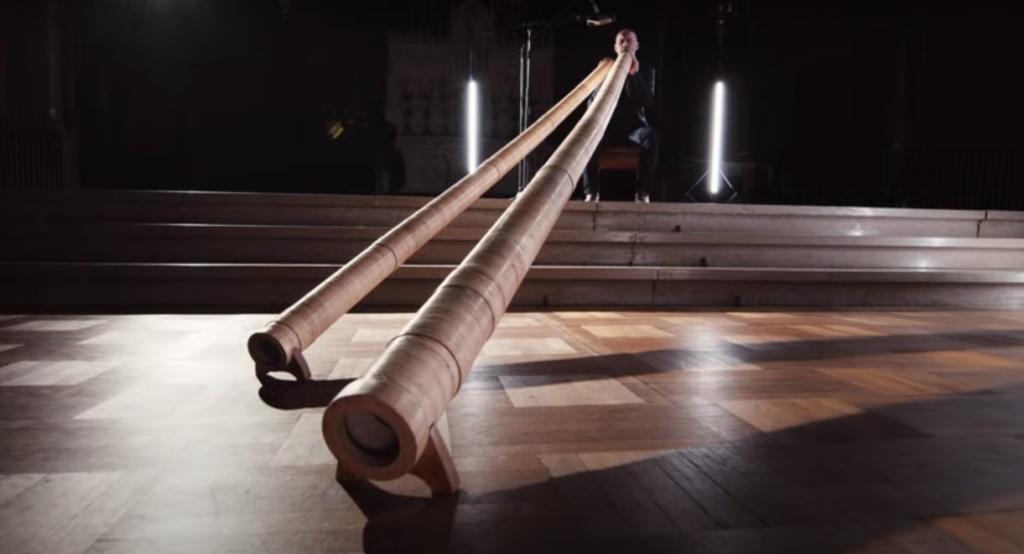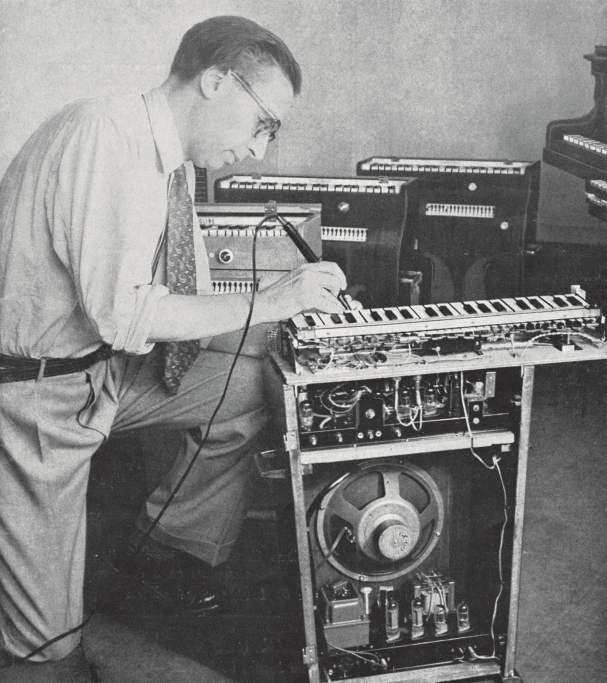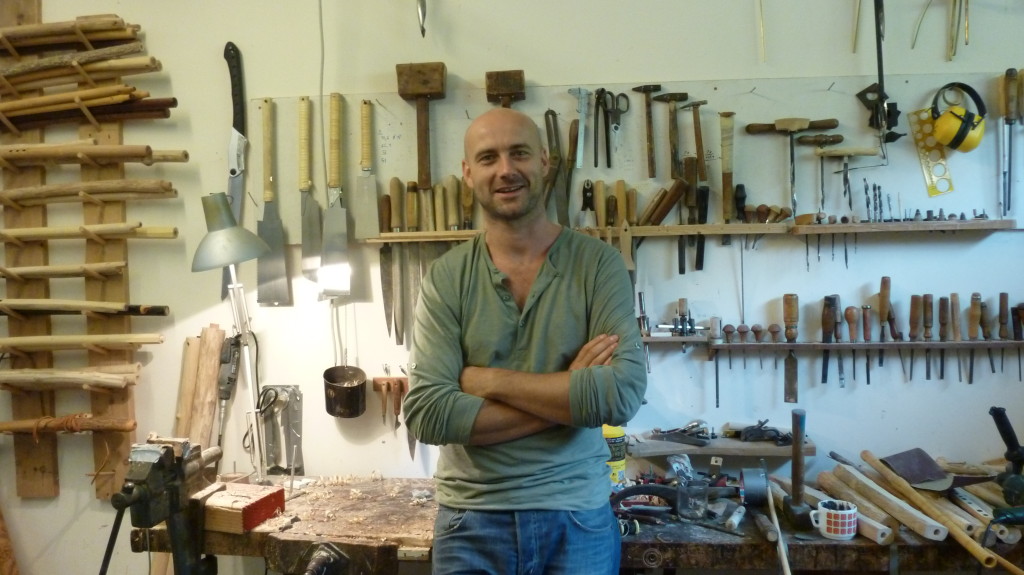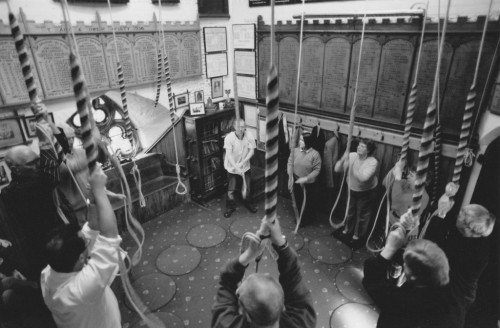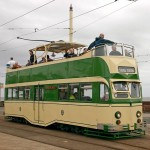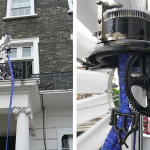Musician Germán Canyelles uses Low-tech Magazine’s bike generator to power his electric guitar. The guitar amplifier and pedals are plugged into an inverter connected to the 12V circuit of the bike generator. No batteries are used. Recorded at Akasha Hub, Barcelona.
Human Powered Electric Guitar
The World’s Largest Flutes
Winne Clement made and recorded these huge Overtone flutes for The soundtrack of the Movie ‘The Whale’ by Darren Aronofsky. Check out the video on YouTube. We interviewed Winne Clement a few years ago.
The Ondioline
The Ondioline is an electronic musical instrument invented by Georges Jenny in France in the early 1940s and developed through a number of different models until his death in 1975. This versatile and expressive instrument is monophonic, but can produce a remarkable variety of sounds, from simulating orchestral instruments to creating unique and voice-like tones.
In total, around 1200 Ondiolines were built between the mid 1940s and late 1960s, most of them handmade by Jenny himself. The instrument was also offered in “kit” form, where Jenny recommended purchasing the more complex assemblies – such as the keyboard – as complete units. The schematics were made available for amateur engineers to construct their own custom instruments, and they were encouraged to experiment with the amplifier, tone circuits and cabinetry.
Although a number of musicians played Ondiolines in eclectic contexts through the years, the instrument’s main proponent and arguably sole virtuoso was Jean-Jacques Perrey [1929-2016]. After meeting Jenny around 1950, Perrey became the Ondioline’s official demonstrator and traveling salesman, later using the instrument on a number of pioneering electronic pop records. His technique of self-accompanying – playing the piano with his left hand while fluidly changing sounds and soloing on Ondioline with his right hand and knee – was a feat of remarkable musical dexterity.
Since 2016 the musician Gotye has worked to revive interest in the Ondioline through the non-profit Forgotten Futures and with an ensemble called Ondioline Orchestra that performs tributes to Jean-Jacques Perrey’s music. Forgotten Futures is dedicated to the recovery of Jenny’s under-recognized work, the recreation of critical Ondioline spare parts, and the dissemination of information that will ensure the functionality and accessibility of these remarkable instruments for future generations.
Read, see & listen:
Hand Crank Marble Machine
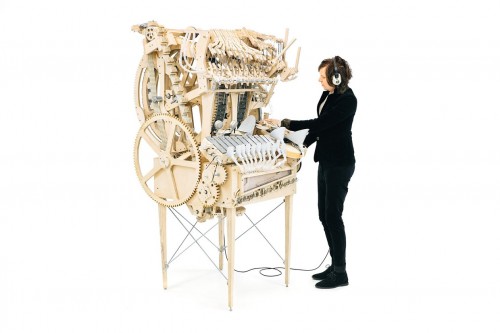 “The Wintergartan Marble Machine, built by Swedish musician Martin Molin and filmed by Hannes Knutsson, is a hand-made music box that powers a kick drum, bass, vibraphone and other instruments using a hand crank and 2,000 marbles.”
“The Wintergartan Marble Machine, built by Swedish musician Martin Molin and filmed by Hannes Knutsson, is a hand-made music box that powers a kick drum, bass, vibraphone and other instruments using a hand crank and 2,000 marbles.”
Read more at Wired: Wintergatan’s ‘Marble Machine’ makes music with 2,000 marbles.
21st Century Craftsmen: Winne Clement, Flutemaker
The fujara is a long 3-holed fipple flute played in standing position with the flute held close to the body. It’s played using the natural harmonics system, which means the different tones are played by controlling the strength of inblown air. Using only three holes, the diatonic major scale can be reached playing two and a half octaves. Due to the natural harmonics the tuning will always be a compromise, but Belgian flutemaker and musician Winne Clement puts a great deal of effort in tuning and balancing the tones, in such a way that playing together with Western tuned instruments is possible.
All his flutes are made of harvested branches of local inland wood such as ash, elder, maple, hazle, etc. The wood is carefully chosen and cut in winter time – with respect for the environment, not damaging the donating trees – and put to dry for a long period of time. When making the flute the wood is never split in half to hollow it out, but hand-drilled with special old forged drills, leaving the main structure of the wood intact, benefiting the sound, and following the natural curves of the wood. No Tech Magazine visits Winne Clement in his studio in Ghent, where he explains us his tools and methods. [Read more…]
Change Ringing
Despite the curtailing of their liturgical uses, at the beginning of the seventeenth century a lot of church bells remained hanging in church towers. Ringing them was an activity pursued with great enthusiasm, often by groups of boozy young men. Paul Hentzner, a German lawyer who traveled through England in the final years of the sixteenth century, wrote that the English were “vastly fond of great noises that fill the ear, such as the firing of cannon, drums, and the ringing of bells, so that it is common for a number of them, that have got a glass in their heads, to go up into some belfry, and ring the bells for hours together for the sake of exercise.”
It was in these long, beer-fuelled ringing sessions that change ringing was invented, as a codification of the disorganized ringing that Hentzner describes. It seems to have started in London and southeast England in the early seventeenth century; it spread, and by the 1660s was a fashionable recreation, with societies springing up all over south, central, and eastern England to further the practice.
